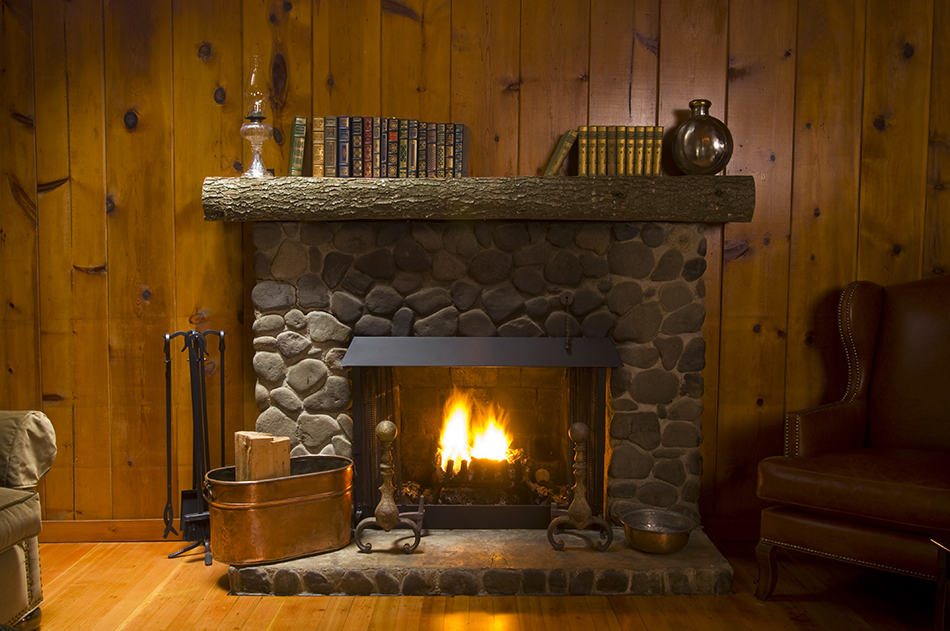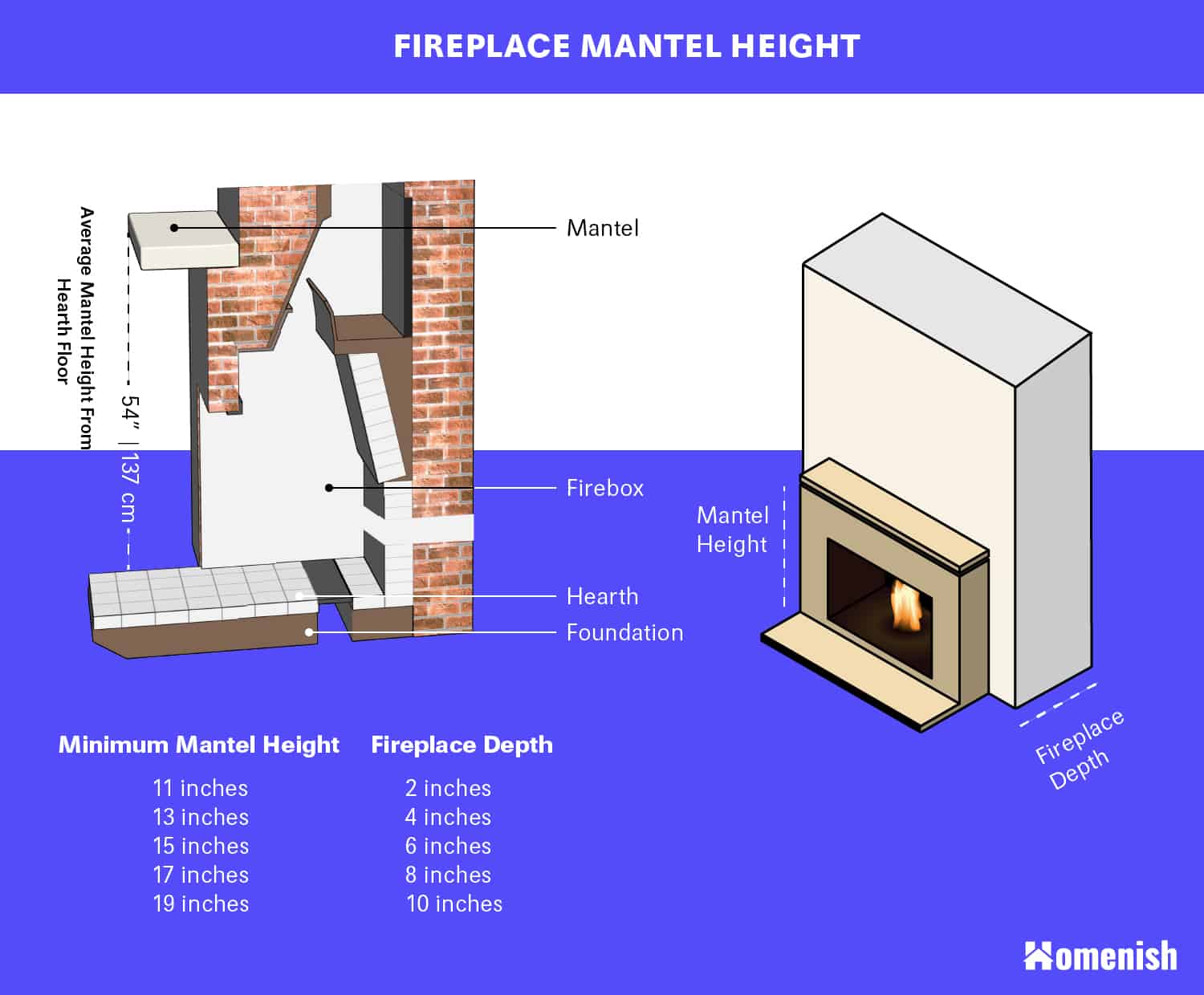How high do you need your mantel to be? Fireplace mantel height depends on the depth of your fireplace and how you want to use the space above the mantel. Before explaining the ideal height, you should read our post about the anatomy of a fireplace to understand where the mantel is and how it is connected with other fireplace parts.
The average mantel height is 54 inches above the floor of the hearth. Notice this isn’t the height from the floor. In most cases, your hearth will be raised above the floor by a few inches up to one foot. But this 54-inch mark only gives you a starting point.
According to national fire codes, your mantel needs to be a minimum of a certain number of inches higher than the top of the fireplace’s firebox. This is the flat area of the fireplace, not taking into account any curvature for the flue.
The minimum clearance is based on the depth of your fireplace. Here are the common height requirements for household fireplaces:
- A fireplace 2 inches deep = 11 inches minimum mantel height
- A fireplace 4 inches deep = 13 inches minimum mantel height
- A fireplace 6 inches deep = 15 inches minimum mantel height
- A fireplace 8 inches deep = 17 inches minimum mantel height
- A fireplace 10 inches deep = 19 inches minimum mantel height
And you can continue this pattern for deeper fireplaces or for those with depths falling in between these measurements. You simply add 1 inch of mantel height for every inch of fireplace depth.
Note: Some manufacturers require a minimum of 12 inches rather than the standard 11 inches of mantel height for their wood-burning fireplaces.
Here is a great diagram that explained the detailed height of a fireplace mantel.
How Deep Does Your Mantel Need to Be?
Besides height, it’s also regulated that your mantel overhangs the fireplace by at least 3 inches. This means that if the fireplace is fully inset into the wall, your mantel will be at least 3 inches deep. This is enough to block any sparks jumping out of the fireplace and absorb the bulk of the heat as it rises out of the fireplace.
If your fireplace protrudes from the wall, you’ll need to add depth to your mantel by that same amount so that the mantel is always 3 inches further out from the wall than the fireplace is.
What’s the Ideal Length for Your Mantel?
While this isn’t regulated, the standard is to have the mantel extend 6 inches on either side of the fireplace. If you have a raised hearth, you may also want this to be of the same length as the mantel to ensure everything looks symmetrical and that the fireplace is even centered lengthwise between the two.
If your mantel or hearth is too long, it will make the fireplace look smaller; too short, and the mantel will look out of proportion compared to the fireplace.
How Thick Does Your Mantel Need to Be?
Here’s where fire safety may seem counterintuitive. If you’re using thinner materials to make the mantel, such as wood planks, it only needs to be 3 inches thick.
But if you’re using some thicker material, like decorative logs, it needs to be 7 inches thick. This is because the thinner materials will lose heat faster, while the thicker material will absorb and retain the heat.
What Should Your Mantel Be Made Of?
Remember that your mantel is meant to absorb the heat rising out of the fireplace so that it doesn’t overheat the wall above it. As a rule, then, you should build it out of nonflammable materials – concrete, stone, glass, etc. And be careful when repairing or painting your mantel. Make sure the materials you use are noncombustible.
How Large Should Your Fireplace Be?
Your fireplace or mantel needs to be proportional to the size of your room. Too large of a fireplace will overpower everything else in the room; too small of a fireplace can look miniature-sized.
Mantels are generally between 4 feet and 6 feet above the floor. If you have a room-sized 180 square feet or more, aim to have your mantel six feet above the floor. A room of 120 square feet should have a mantel centered at about 4.5 feet above the floor. Make sure to see our post on living rooms with fireplaces and TVs to get some ideas on how to fit your fireplace.
Using the Space above Your Mantel
The fireplace and mantel will take up a large portion of that section of the wall. Luckily, though, you do have some clearance above the mantel to hang something else.
Most ceilings are 9 feet high, so if your mantel comes up to the standard 4.5-6 feet, you’ll have 3-3.5 space between it and the ceiling. In that area, you might hang family photos, install a bookshelf, or use it as a place to mount your TV.
This third option is the most common. Because the fireplace is generally centered on the wall so that it can serve as a focal point in the room, it makes sense to place the TV in the same area. In this case, you might have shelves on either side of the fireplace for storing game systems, DVDs, ROKU boxes, etc.
Of course, when you mount an electronic device above the mantel, you want to make sure you’re leaving enough clearance for it not to be damaged by any heat coming out of the fireplace. Heat rises, after all, and it will ascend primarily right in front of the fireplace.
If you’ve installed your mantel properly, that will block most of the heat coming from the fireplace, so if the bottom of the TV or anything else you hang on the wall is between 6 and 12 inches above the mantel, it should be well out of harm’s way. Just make sure the area above the mantel doesn’t reach more than 100 degrees.
Because the TV will be mounted on the wall, make sure to tilt it downward so that you can see it from the proper angle when sitting on the couch or in your chair. If you move your furniture, you can always adjust the angle of the TV on the mount.
Of course, you may not want to have the TV or other decorations come right up to the ceiling, especially if you have crown molding. It looks best to leave at least 3 inches of clearance between anything you hang on the wall and the top of the ceiling.
If you’re hanging a TV, this means you might want to get one that measures 27 inches tall. It doesn’t matter if the TV’s width extends over the length of the mantel, so you can mount a good-sized widescreen TV in this space.







